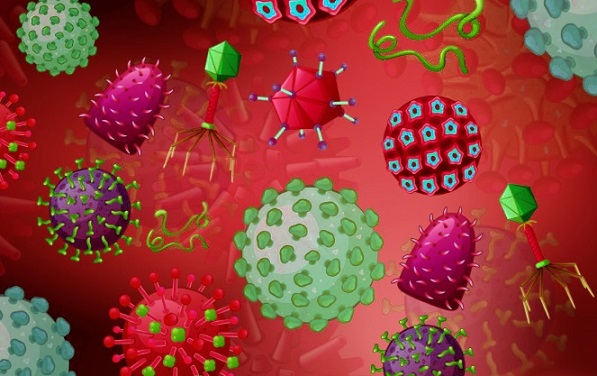Understanding How Host Cells Defend Against Viruses Through Natural Restriction Mechanisms
Nikhil Prasad Fact checked by:Thailand Medical News Team Feb 09, 2025 2 months, 4 days, 5 hours, 59 minutes ago
Medical News: Viruses are a major threat to human health, with many capable of causing severe illnesses. Diseases like COVID-19, influenza, hepatitis B, and even HIV all stem from viral infections that exploit the human body's cells for replication. However, our bodies are not defenseless. Scientists from several prestigious institutions, including the National Institute of Pathogen Biology at the Chinese Academy of Medical Sciences and Beijing Pediatric Research Institute, have studied a group of proteins called host restriction factors (HRFs). These proteins naturally help protect human cells from viral invasion.
 Understanding How Host Cells Defend Against Viruses Through Natural Restriction Mechanisms
Understanding How Host Cells Defend Against Viruses Through Natural Restriction Mechanisms
This
Medical News report delves into the fascinating world of HRFs and how they act as the body's natural defense system against viral infections. These antiviral proteins interfere with different stages of a virus’s life cycle, from blocking entry into cells to stopping the virus from replicating or spreading. Understanding how these HRFs work is crucial in developing new treatments and antiviral drugs in the future.
How Host Restriction Factors Work
Host restriction factors (HRFs) are proteins in human cells that prevent viruses from replicating. Researchers classify these factors into two categories: interferon-stimulated genes (ISGs) and non-interferon-stimulated genes (non-ISGs). ISGs are activated when the body detects a virus and launches an immune response, while non-ISGs are always present in the cell and serve as a baseline defense.
HRFs work in different ways, such as:
-Blocking Viral Entry - Some HRFs, like interferon-induced transmembrane proteins (IFITMs), LY6E, and Zinc Metallopeptidase STE24 (ZMPSTE24), prevent viruses from entering human cells by interfering with their ability to fuse with cell membranes.
-Preventing Viral Replication - Factors like APOBEC3 proteins modify viral genetic material, making it harder for viruses like HIV and hepatitis B to replicate.
-Disrupting Viral Protein Production - Certain HRFs, including zinc-finger antiviral protein (ZAP), stop viral proteins from forming properly, which weakens the virus and prevents it from multiplying.
-Inhibiting Virus Assembly and Release - Some HRFs, such as BST-2 (Tetherin), prevent new virus particles from leaving infected cells, limiting their ability to spread.
Key Host Restriction Factors and Their Roles
Several HRFs have been identified as crucial players in antiviral defense. Here are some of the most important ones:
-IFITM Proteins (IFITM1, IFITM2, IFITM3) - These proteins prevent viruses like influenza, Zika, and coronaviruses from entering human cells by making membranes more rigid and less prone to viral fusion.
ong>-Zinc Metallopeptidase STE24 (ZMPSTE24) - Works together with IFITMs to enhance their antiviral effects, especially against SARS-CoV-2 and vesicular stomatitis virus (VSV).
-Cholesterol 25-Hydroxylase (CH25H) - Produces a compound called 25-hydroxycholesterol (25HC), which disrupts the membranes of enveloped viruses, stopping them from entering human cells.
-Apolipoprotein B mRNA-Editing Enzyme Catalytic Polypeptide 3 (APOBEC3) - Introduces genetic mutations into viral DNA, effectively rendering the virus unable to replicate properly.
-Zinc-Finger Antiviral Protein (ZAP) - Selectively binds viral RNA and degrades it, preventing viruses like HIV, hepatitis B, and coronaviruses from multiplying.
-Tripartite Motif-Containing Proteins (TRIMs) - These proteins tag viral components for destruction and enhance immune signaling pathways to alert the body of an infection.
-Bone Marrow Stromal Cell Antigen 2 (BST-2 or Tetherin) - Prevents newly made viruses from leaving an infected cell, slowing their spread in the body.
Lymphocyte Antigen 6 Family Member E (LY6E) - Alters cell membrane properties, making it harder for viruses, including coronaviruses and HIV, to enter human cells.
How These Factors Influence Drug Development
Scientists believe that understanding HRFs could lead to new treatments for viral infections. Current antiviral drugs often target viruses directly, but these viruses mutate quickly, making treatments less effective over time. By targeting HRFs instead, researchers may be able to develop drugs that provide broader protection against multiple viruses while also reducing the risk of drug resistance.
One promising approach is using small molecules to enhance the activity of HRFs. For example, drugs that stabilize the activity of APOBEC3 proteins could help suppress HIV replication more effectively. Similarly, boosting the effects of IFITMs and ZMPSTE24 could help prevent the entry of coronaviruses like SARS-CoV-2 into human cells.
The Future of Research on Host Restriction Factors
Although HRFs are a powerful tool in the body’s fight against viruses, there is still much to learn. Scientists continue to investigate how different HRFs interact with each other and how viruses have evolved to bypass these natural defenses. For example, some viruses produce proteins that neutralize HRFs, allowing them to continue replicating despite the body’s best efforts.
Researchers are also looking at how HRFs can be used in personalized medicine. By understanding which HRFs are most active in an individual’s body, doctors may be able to predict how well someone will respond to a viral infection and tailor treatments accordingly.
Conclusion
Host restriction factors play an essential role in protecting human cells from viral infections. These naturally occurring proteins disrupt viral entry, replication, and spread, providing an effective first line of defense against many diseases. Scientists from the National Institute of Pathogen Biology, Beijing Pediatric Research Institute, and other leading institutions have made significant progress in understanding how HRFs work. Their research could lead to new antiviral drugs that work by boosting the body's natural defenses rather than directly targeting viruses.
While there is still much to learn, the study of HRFs represents an exciting frontier in medical research. By continuing to explore these natural defense mechanisms, scientists hope to develop better strategies to combat infectious diseases and protect human health in the future.
The study findings were published in the peer-reviewed journal: Frontiers in Immunology.
https://www.frontiersin.org/journals/immunology/articles/10.3389/fimmu.2025.1484119/full
For the latest on Viruses, keep on logging to Thailand Medical News.
Read Also:
https://www.thailandmedical.news/news/understanding-the-relationship-between-viruses-and-cell-death
https://www.thailandmedical.news/news/protacs-new-antiviral-approach-to-combatting-viruses
https://www.thailandmedical.news/news/viruses-and-neurodegenerative-diseases
